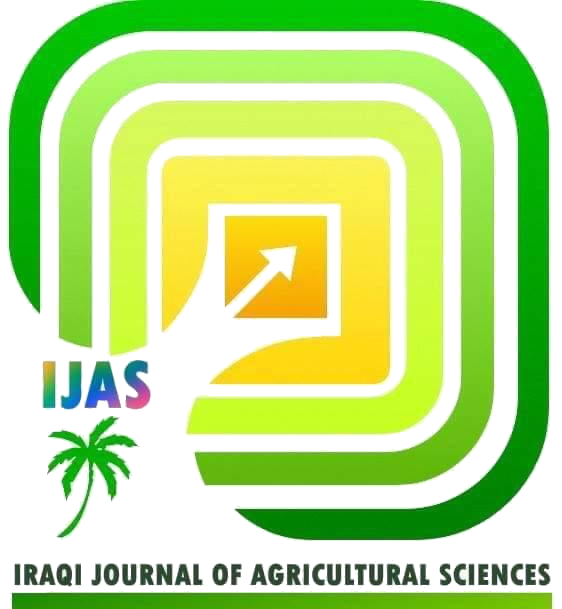MOLECULAR AND PHYSIOLOGICAL CHARACTERIZATION OF Fusarium oxysporum ciceri ISOLATES FROM DIFFERENT CHICKPEA AREAS IN IKR, IRAQ
DOI:
https://doi.org/10.36103/61f11n23Keywords:
Cicer arietinum, Fusarium wilt, Physiological races, Virulence analysis.Abstract
Thirty-seven different F. oxysporum ciceri isolates were isolated from 55 chickpea fields at Sulaimani and Halabja governorates during 2021. Fourteen Foc isolates were pathogenic and displayed various morphological traits. The ideal temperature for Foc ranged 25-30°C. PDA was the best media for the fungal growth. The isolates showed a variety of growth patterns, including appressed, flat/velvet, fluffy to partial fluffy, and cottony. However, Foc-28 displays nerve type mycelium growth on PDA at 25ºC. Microconidia (6.1-8.7x2.9-4.98µm), macroconidia (10.0-20.1x2.7-5.2µm), chlamydospores (7.2-15.0x6.8-10.7µm), and colony diameter on PDA were all significantly differed among the isolates. Significant differences in virulence of 14 Foc isolates were detected on 10 chickpea wilt differentials. The isolates were classified in to two groups and ten physiological races accordingly. Each isolate’s genomic DNA was amplified by the ITS primers to a maximum size of 400bp, producing a single band for each accession. The basic local alignment search tool (BLAST) analysis supported the morphological identification, whereby the closest match 99-100% in the NCBI GenBank database. The accession numbers for the sequences were registered at the NCBI gen bank under different codes. The phylogenetic tree proposed two major clades with stains distributed across the dendrogram irrespective of their geographic status.
References
1. Abd-Elsalam, K.A., I.N. Aly, M.A. Abdel-Satar, M.S. Khalil, and J.A. Verreet. 2003. PCR identification of Fusarium genus based on nuclear ribosomal-DNA sequence data. Af. J. of Biot. 2(4): 82-85. https://doi.org/10.5897/AJB2003.000-1016
2. Al-Maaroof, E.M. and N.M. Saber. 2019. Occurrence and biological control of cucumber damping off disease under protected cultivation in Sulaimani, Iraq. Int. J. of Annov. Appr. In Agr. 3(2): 229-246. https://doi.org/10.29329/ijiaar.2019.194.9
3. Al-Maaroof, E.M and P.H. Saed. 2023. Resistance of Iraqi wheat cultivars to common bunt disease and molecular diagnosis of the available Bt genes in each cultivar. Iraqi Journal of Agricultural Sciences, 54(6): 1760-1772. https://doi.org /10.36103/ijas.v54i6.1875
4. Al-Maaroof, E.M and R.M. Saleh, 2022. Physiological and molecular characterization of Ascochyta rabiei isolates from various chickpea areas across IKR, Iraq. The Iraqi J. of Agri. Sci. 53(2): 297-314. https://doi.org/10.36103/ijas.v53i2.1537
5. Al-Taae, A.K., H.A. Hadwan, and S.E. Al-Jobory. 2013. Pathogenic variability in isolates of Fusarium oxysporum f. sp. ciceris in Iraq. Sci. J. Univ. Zakho 1(A): 108-114. https://sjuoz.uoz.edu.krd/index.php/sjuoz/article/view/52
6. Amine, E., A. Douira, M. Ilyass and S. Ahmed. 2022. Integrating sowing date with Chickpea genotypes in managing Fusarium wilt in Morocco. Agriculture. 12(6): 773. https://doi.org/10.3390/agriculture12060773
7. Bayraktar, H., and F. S. Dolar. 2012. Pathogenic variability of Fusarium oxysporum f. sp. ciceri isolates from chickpea in Turkey. Pak. J. Bot. 44: 821-823. http://142.54.178. 187:9060/xmlui/handle/123456789/15403
8. Cha, J.Y., S. Han, H.J. Hong, H. Cho, D. Kim, Y. Kwon, and J.F. Kim. 2016. Microbial and biochemical basis of a Fusarium wilt-suppressive soil. The ISME J. 10(1): 119-129.
https://doi.org/10.1038/ismej.2015.95
9. Chaudhry, M., M. Ilyas, F. Muhammad, and M. Ghazanfar. 2007. Sources of resistance in chickpea germplasm against fusarium wilt. Mycopath. 5(1): 17-21. http://111.68.103.26/journals/index.php/mycopath/article/viewFile/194/99
10. Dubey, S., S.R. Singh, and B. Singh. 2010. Morphological and pathogenic variability of Indian isolates of Fusarium oxysporum f. sp. ciceri causing chickpea wilt. Arch. of Phytopath., and Pl. Prot. 43(2): 174-190. https://doi.org/10.1080/03235400802021108
11. Golakiya, B., M. Bhimani, and L. Akbari. 2018. Characterization of Indian isolates of Fusarium oxysporum f. sp. ciceri causing chickpea wilt. Int. J. Curr. Microbiol. App. Sci. 7(3): 1152-1162. https://doi.org/ 10.20546/ijcmas.2018.703.137
12. Gupta, O., M. Khare, and S. Kotasthane. 1986. Variability among six isolates of Fusarium oxysporum f. sp. ciceri causing vascular wilt of chickpea. Ind. Phytopathol. 39: 279-281
13. Hashem, A., B. Tabassum, and E.F. Abdallah. 2020. Omics approaches in chickpea Fusarium wilt disease management. Management of Fungal Pathogens in Pulses. Springer. 57-72. https://doi.org/10.1007/978-3-030-35947-8_4
14. Haware, M., Y. Nene, and M. Natarajan. 1996. The survival of Fusarium oxysporum f. sp. ciceri in the soil in the absence of chickpea. Phytopath. Med. 35(1): 9-12. https://www.jstor.org/stable/42685234
15. Jiménez-Gasco, M., E. Pérez-Artés, and R.M. Jiménez-Diaz. 2001. Identification of pathogenic races 0, 1B/C, 5, and 6 of Fusarium oxysporum f. sp. ciceri with random amplified polymorphic DNA (RAPD). Eu. J. of Plant Path. 107(2): 237-248. https://doi.org/10.1023/A:1011294204630
16. Jimenez-Gasco, M.M., and R.M. Jimenez-Díaz. 2003. Development of a specific polymerase chain reaction-based assay for the identification of Fusarium oxysporum f. sp. ciceri and its pathogenic races 0, 1A, 5, and 6. Phytopath. 93: 200-209. https://doi.org/10.1094/PHYTO.2003.93.2.200
17. Kaur, A., V. K. Sharma, A. Sirari, J. Kaur, G. Singh, and P. Kumar. 2015. Variability in Fusarium oxysporum f. sp. ciceris causing wilt in chickpea. African Journal of Microbiology Research. 9(15): 1089-1097. https://doi.org/10.5897/AJMR2014.7267
18. Khanzada, S.A., S.M. Iqbal, and A.M. Haqqani. 2003. Physiological studies on Macrophomina phaseolina. Mycopath.1:31-34. http://111.68.103.26/journals/index.php/
mycopath/article/viewFile/5573/2608
19. Landa, B.B., J.A. Navas-Cortés, M. del Mar Jimenez-Gasco, B. Retig, and R.M. Jiménez-Díaz. 2006. Temperature response of chickpea cultivars to races of Fusarium oxysporum f. sp. ciceri, causal agent of Fusarium wilt. Pl. Dis. 90(3): 365-374. https://doi.org/10.1094/PD-90-0365
20. Lara B.Y., and B.S. Almaliky. 2024. Morphology, molecular identification, pathogenicity and first report of Fusarium equiseti associated with root rot and wilt disease of Catharanthus roseus in Baghdad, Iraq. Iraqi Journal of Agricultural Sciences, 55(6): 2153-2163.
https://doi.org/10.36103/tjptrn68
21. Maitlo, S., R. Syed, M. Rustamani, R. Khuhro, and A. Lodhi. 2016. Influence of inoculation methods and inoculum levels on the aggressiveness of Fusarium oxysporum f. sp. ciceri on chickpea plant growth. Int. J. of Agri. and Biol. 18: 31-36. https://doi.org/10.5555/20163061056
22. Manjunatha, L., A. Puyam, G. Prema, M. Bandi, R. Kumar and T. Kavitha. 2022. Chickpea biotic stresses, genomic designing for biotic stress, resistant pulse crops. Springer. 117-159. https://doi.org/10.1007/978-3-030-91043-3_2
23. Mina, U., and S.C. Dubey. 2010. Effect of environmental variables on development of Fusarium wilt in chickpea (Cicer arietinum) cultivars. Ind. J. Agric. Sci. 80(3): 231-234.
https://epubs.icar.org.in/index.php/IJAgS/article/view/245
24. Nath, N., A. Ahmed, and F. Aminuzaman. 2017. Morphological and physiological variation of Fusarium oxysporum f. sp. ciceri isolates causing wilt disease in chickpea. Int. J. of Env. Agri. and Biot. 2(1): 202-212. http://dx.doi.org/10.22161/ijeab/2.1.25
25. Navas-Cortés, J.A., B.B. Landa, M.A. Méndez-Rodríguez, and R.M. Jiménez-Díaz. 2007. Quantitative modeling of the effects of temperature and inoculum density of Fusarium oxysporum f. sp. ciceri races 0 and 5 on development of fusarium wilt in chickpea cultivars. Phytopathol. 97(5): 564–573. https://doi.org/10.1094/PHYTO-97-5-0564
26. Nelson, P.E., M.C. Dignani, and E.J. Anaissie. 1994. Taxonomy, biology, and clinical aspects of Fusarium species. Clinical microbiology reviews. 7(4): 479-504. https://doi.org/10.1128/cmr.7.4.479.
27. Pampana, S., A. Masoni, M. Mariotti, L. Ercoli, and I. Arduini. 2018. Nitrogen fixation of grain legumes differs in response to nitrogen fertilisation. Experimental Agriculture. 54(1): 66-82. https://doi.org/10.1017/S0014479716000685
28. Paulkar, P.K., B.T. Raut, and K.B. Kale. 2001. Nutritional studies on four isolates of F. oxysporum f. sp. ciceri. New Agri. 12: 89-91.
https://doi.org/10.15740/HAS/IJPS/11.2/213-217
29. Reddy, S.A., C. Kushwaha, and B.D Prasad. 2022. Analyzing influence of thermal and osmotic stress on native isolates of Fusarium oxysporum f. sp. cubense. Ind. Phytopathol.75: 863-868. https://doi.org/10.1007/s42360-022-00514-8
30. Sanghvi, G., K. Bhimani, D. Vaishnav, T. Oza, G. Dave, and N. Sheth. 2016. Mitigation of acrylamide by l-asparaginase from Bacillus subtilis KDPS1 and analysis of degradation products by HPLC and HPTLC. Springer Plus. 5(1): 1-11. https://doi.org/10.1186/s40064-016-2159-8
31. Sharma, K.D., W. Chen, and F.J. Muehlbauer. 2005. Genetics of chickpea resistance to five races of Fusarium wilt and a concise set of race differentials for Fusarium oxysporum f. sp. ciceris. Pl. Dis. 89:385-390. https://doi.org/10.1094/PD-89-0385
32. Shawket, S., S. Bashir, M.N. Mughal, R.u.R. Mir, F. Bhatt, and T. Shah. 2018. Identification of sources of resistance against wilt (Fusarium oxysporum f.sp. ciceri) in Chickpea genotypes under temperate agro-climatic conditions of kashmir. Int. J. Cur. Mic. App. Sci. 7(9):195-199. https://doi.org/10.20546/ijcmas.2018.709.025
33. Shehabu, M., S. Ahmed, K. Sakhuja. 2008. Pathogenic variability in Ethiopian isolates of Fusarium oxysporum f. sp. ciceri and reaction of chickpea improved varieties to the isolates. Int. J. of Pest Man. 54(2): 143-149. https://dio.org/10.1094/PD-89-0385
34. Tamura, K., G. Stecher, D. Peterson, and S. Kumar. 2013. MEGA6: molecular evolutionary genetics analysis version 6.0. Mol. Biol. and Evol. 30(12): 2725-2729. https://dio.org/10.1093/molbev/mst197
35. Upasani M.L., B.M. Limaye, G.S. Gurjar, S.M. Kasibhatla, and V.S. Gupta. 2017. Chickpea-Fusarium oxysporum interaction transcriptome reveals differential modulation of plant defense strategies. Sci Rep.7: 1-12. https://dio.org/10.1038/s41598-017-07114-x
36. Younesi, H., M. Darvishnia, E. Bazgir and K. Chehri. 2021. Morphological, molecular and pathogenic characterization of Fusarium spp. associated with chickpea wilt in western Iran. J. of Pl. Prot. 61(4): 402–413. https://dio.org/10.24425/jppr.2021.139250
Downloads
Published
Issue
Section
License
Copyright (c) 2025 IRAQI JOURNAL OF AGRICULTURAL SCIENCES

This work is licensed under a Creative Commons Attribution-NonCommercial-NoDerivatives 4.0 International License.

2.jpg)


